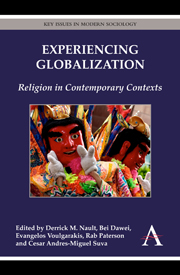Book contents
- Frontmatter
- Contents
- Preface
- Chapter 1 Introduction
- Part One Religion in Global and Transcultural Perspective
- Chapter 2 Adam Smith and the Neo-Calvinist Foundations of Globalization
- Chapter 3 Daniel Quinn on Religion: Saving the World through Anti-globalism?
- Chapter 4 Globalized Religion: The Vedic Sacrifice (Yajña) in Transcultural Public Spheres
- Part Two Comparative and Pluralistic Approaches
- Part Three Religion in Taiwan
- List of Contributors
Chapter 4 - Globalized Religion: The Vedic Sacrifice (Yajña) in Transcultural Public Spheres
from Part One - Religion in Global and Transcultural Perspective
Published online by Cambridge University Press: 05 May 2013
- Frontmatter
- Contents
- Preface
- Chapter 1 Introduction
- Part One Religion in Global and Transcultural Perspective
- Chapter 2 Adam Smith and the Neo-Calvinist Foundations of Globalization
- Chapter 3 Daniel Quinn on Religion: Saving the World through Anti-globalism?
- Chapter 4 Globalized Religion: The Vedic Sacrifice (Yajña) in Transcultural Public Spheres
- Part Two Comparative and Pluralistic Approaches
- Part Three Religion in Taiwan
- List of Contributors
Summary
Introduction
In times of flux, such as our current era of globalization, culture and cultural identity can become more meaningful for individuals who may feel alienated or even threatened by forces beyond their control. To make sense of their changing surroundings, people accordingly emphasize their uniqueness and exclusiveness by referring to their group’s common ancestry, history, language or religion, as well as to shared customs or values. Identification is made as such with cultures or, as Samuel Huntington (1996) argued in his highly influential book The Clash of Civilizations and the Remaking of World Order, with civilizations. Of the many elements helping to define civilization, one of the most important is religion. Of Max Weber’s five world religions, four—Christianity, Islam, Hinduism and Confucianism—are associated with major civilizations and are, therefore, as Dawson (1978) suggests, “the foundations on which the great civilizations rest” (128).
While focusing on the “West” as one civilizational entity and hindu civilization as another representing the so-called “east,” the present paper investigates globalization's impact on religious practices through an analysis of yajña, an Indian form of worship with ancient Vedic roots characterized by the act of giving oblation to divinities through sacrificial offerings into fire. At first sight, it might seem strange to focus on this traditionally Indian ritual to understand globalization’s significance, but this rite currently occurs in both East and West, where it is conducted by people from either civilizational tradition whose ideas and intentions associated with the rite differ accordingly.
- Type
- Chapter
- Information
- Experiencing GlobalizationReligion in Contemporary Contexts, pp. 59 - 78Publisher: Anthem PressPrint publication year: 2013



